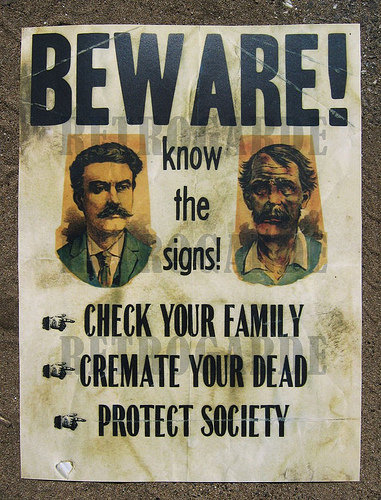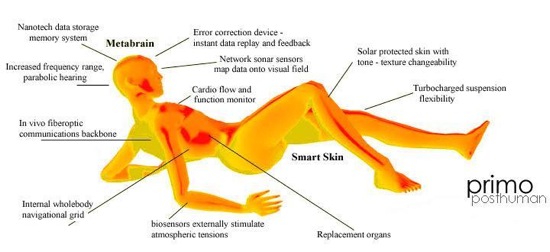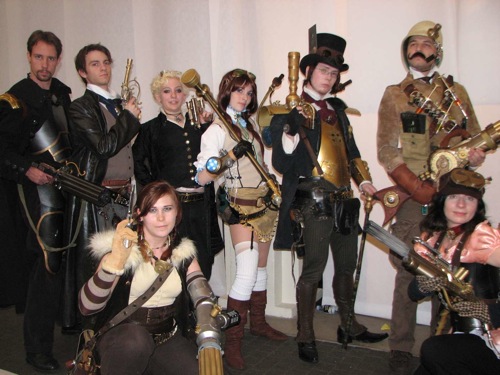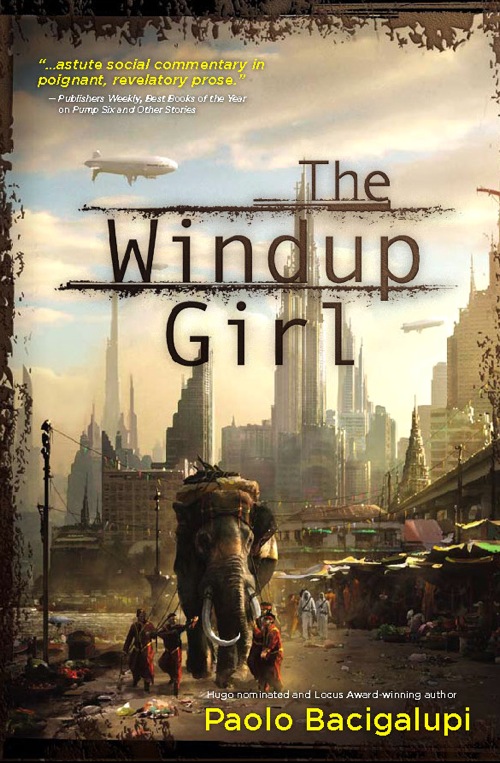Into the Void (6)
By:
July 30, 2010

Our imaginations are caught between two unstoppable empires: the retrofuturistic world of steampunk, and the shambling hordes of zombies. The only thing more popular than a steampunk world or a zombie world is steampunk with zombies [see poster above]. But what’s next?
When I think about these two strands of speculative fiction culture, it occurs to me that our love of steampunk and our fascination with zombies are two sides of the same coin.
Zombie pessimism
Steampunk represents an idealized past, while zombies represent a horrible future. So they’re both outlets for our inexorable pessimism about our current era.

Every time we think maybe we’re ready for a moment of sunny optimism about the future of humanity, somebody goes and fills the Gulf of Mexico with unrefined crude. Or the North Koreans decide to bring World War III just a smidge closer. Etc. To my mind, zombies represent our mindless drive to self-destruction. In almost every incarnation of the zombie story, they can’t be reasoned with, and they can only destroy, not create. They’re not charismatic like vampires or tragic like werewolves. They are the most apocalyptic of monsters because they leave nothing but debris are more zombies behind.

True, we’ve had a flood of hyper-optimistic books about our amazing post-human descendants. It’s easy to be optimistic about a future where we’ve leapfrogged over all of our current problems. We’re no longer shackled to one body forever, our brains are no longer limited to the cramped real estate in our skulls, computers are brilliant and occasionally our friends, etc. etc. But I’m seeing fewer of those now than a couple years ago.
The dark side of post-humanity
Zombies are the dark side of the post-human vision. They’re immortal, and they’re no longer hindered by the constraints of normal human intelligence. You can even remove a zombie’s arms and he’ll keep shambling, like a post-human removing a synthetic limb. But zombies are post-human in a way that utterly sucks. Zombies are an unpleasant rejoinder to the starry-eyed optimism of the previous wave of post-human books.

Meanwhile, steampunk is the sort of optimism that looks backwards instead of forwards. It’s hard to think of a time when faith in progress was more unshakable than the Victorian era — at least for the privileged classes. But Victorian literature is full of sharp questions about industrial progress, even though our popular idea of the Victorian era is that it was bright and forward-looking.
Steampunk is also about the love of our industrial past, which still haunts us like a zombie. The industrial revolution has left abandoned factories all across the Western world, and the slow death of manufacturing is like a seeping wound in our post-industrial economies. Steampunk, also, is about a time when we were learning to love coal, the most polluting of the fossil fuels, and that love affair led inexorably to our current oceanpocalypse.
What comes next?
Our world will keep feeling apocalyptic for the foreseeable future. And our fiction will continue to represent our panic about the hopeless present, and maybe a nostalgia for the hopeful past. But possibly we’ll mix it up a bit.

Paolo Bacigalupi’s Nebula-award-winning novel The Windup Girl offers some possible ways forward: the titular Wind-Up Girl is a post-human, but also kind of a zombie. She’s been bio-engineered to move in a jerky way, and her movements are constrained by the fact that she has no pores and therefore overheats easily. She’s a magic realist element in a story that frequently feels apocalyptic and dire, and you can’t help wondering if more bio-hacking weirdness couldn’t be the next generation of our zombie obsession.
I also felt a stirring of hope, a while ago, that novels like Brian Francis Slattery’s Liberation and Robert Charles Wilson’s Julian Comstock could offer a way for us to deal with our 19th century nostalgia without crawling back into the warmth of a semi-idealized, alternate past. Thanks to the cyclical, Santayana’s-curse nature of history, we can have the 19th century in the future. Slavery will come back (as if it ever left), the old conflicts will resurface, and we will once again build beautiful machines out of the ruins of our culture. You only have to look past a time when our lovely, shiny civilization has fallen, and you can shroud us in retro steam clouds once again.
The new escapism
But whatever replaces steampunk and zombies in our hearts will need to have some element of escapism. Steampunk, after all, is pure glamour. And there’s nothing more wish-fulfillment-granting than the idea of being one of the last survivors of an apocalypse, plus zombie-hunting is sort of exciting and swashbuckling. So what new subgenre could possibly address our apocalyptic anxieties, while also giving us a dose of wish-fulfillment?
It’s time for time travel novels to make a comeback. Of course, time travel books never left, as the success of Connie Willis continues to prove. But we aren’t seeing a flood of successful time travel books, and I’m going to make a bold prediction that that might change in the next few years.

Time travel lets us have our nostalgia and our futurism in one story, since you can use incredibly futuristic technology to visit the past. And you can even use time travel to alleviate the scarce resources and extinctions that seem almost certain to worsen in the next few decades — do a Captain Kirk and bring extinct species back from the past. Depending on which theory you use, time travel may allow you to create alternate histories and reinvent the past to your liking, so that you have an excuse to turn Oliver Cromwell into a mutant frog.
But more than any of those things, here’s why I think/hope time travel will make a comeback: it lets us be above, or beyond, history. If you spend any amount of time studying history, you wind up feeling as though there really is something cyclical, inexorable, about it. Progress is not an unbroken line — if we can even agree on what “progress” is. Empires are doomed to fall, utopian projects are doomed to fail. Anything you build will be destroyed. On the personal level, you can be sure that something terrible will happen to everyone you love at some point — you just can’t know what, or when.
Why time travel now?
The ultimate fantasy for people living through the apocalypse is time travel. It’s the only way to stand outside the impersonal machinery of rise and fall, and see the whole pattern from a privileged perspective. A time traveler gets to visit the best times in history without having to see what comes next. But a time traveler can also leapfrog past whatever unthinkable crap awaits us in the 21st century, and see the first blossoming of hope afterward. For a lot of us, it’s the ultimate wish fulfillment, because the ephemeral nature of goodness becomes a matter of variety to be sampled, rather than a curse to be dreaded.
And maybe only a time traveler can save us from our zombie-like tendency to make the same mistakes over and over again, only with more insistence each time around.
Because we dig the sci-fi blog io9, HILOBROW’s editors have curated a collection of critiques by one of our favorite io9ers: Charlie Jane Anders. This is the sixth in a series of ten. This post was first published on June 5, 2010.
